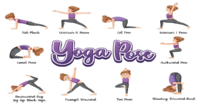Yoga, often associated with asanas or physical postures, is a profound practice that goes far beyond the mat. Rooted in the ancient text The Yoga Sutras of Patanjali, yoga encompasses eight interconnected limbs, collectively referred to as Ashtanga Yoga (“ashta” meaning eight, “anga” meaning limbs). These “8 limbs of Yoga” provide a comprehensive framework for cultivating inner peace, achieving self-realization, and uniting the body, mind, and spirit.
In this blog, we’ll explore these eight limbs, their significance, and how they extend beyond physical practice to enrich our daily lives.
The 8 Limbs of Yoga
1. Yama (Ethical Principles)
The Yamas are moral guidelines for interacting with the world around us. They emphasize:
- Ahimsa(non-violence)
- Satya(truthfulness)
- Asteya(non-stealing)
- Brahmacharya(moderation)
- Aparigraha(non-possessiveness)
Practicing Yamas fosters harmonious relationships and cultivates a sense of compassion and integrity.
2. Niyama (Personal Discipline)
Niyamas focus on self-discipline and inner development. They include:
- Shaucha(cleanliness)
- Santosh(contentment)
- Tapas(self-discipline)
- Swadhyaya(self-study)
- Ishwarapranidhana(surrender to a higher power)
Through Niyamas, one nurtures inner strength, clarity, and spiritual growth.
3. Asana (Physical Postures)
Asana, the physical practice of yoga, serves as a cornerstone for building strength and resilience in the body, preparing it for extended periods of meditation. Beyond enhancing flexibility and balance, it embodies the essential harmony required for physical and mental stability.
4. Pranayama (Breath Control)
Pranayama is the practice of breath control, aimed at channeling life energy (prana). Techniques such as deep breathing, alternate nostril breathing, and kapalabhati serve to:
- Calm the mind
- Enhance focus
- Balance the body’s energy
5. Pratyahara (Withdrawal of Senses)
Pratyahara involves withdrawing the senses from external distractions to focus inward. This practice nurtures self-awareness, fosters introspection, and serves as a bridge to deeper meditative states.
6. Dharana (Concentration)
Dharana involves focused attention on a single object, sound, or thought. This concentration forms the foundation for meditation and strengthens mental discipline.
7. Dhyana (Meditation)
Dhyana represents the state of meditative absorption where the mind achieves profound stillness. This practice cultivates deep inner peace, heightened clarity, and an intimate connection with one’s true self.
8. Samadhi (Union or Bliss)
The ultimate goal of yoga, Samadhi, is the experience of oneness with the universe. It is a state of pure bliss and enlightenment where individual ego dissolves.
Types of Limbs and Their Interconnection
The eight limbs are not separate paths but interrelated practices. For instance, practicing Yamas and Niyamas lays the ethical foundation necessary for deeper spiritual practices like Dhyana and Samadhi. Similarly, mastering Pratyahara enhances Dharana by reducing external distractions, enabling more profound meditation.
Together, these limbs form a complete system for personal transformation—balancing the physical, mental, and spiritual aspects of life.
The Link Between the Limbs and Yoga Practice
While asanas often take center stage in modern yoga, true yogic practice integrates all eight limbs. Yoga is not confined to a one-hour class but is a way of life, encompassing how we treat others (Yama), care for ourselves (Niyama), breathe (Pranayama), and focus our minds (Dharana and Dhyana).
By embracing the limbs holistically, we:
- Develop a deeper understanding of ourselves
- Cultivate mindfulness in every action
- Create harmony within and around us
Benefits of Practicing the 8 Limbs of Yoga
Engaging with the eight limbs offers transformative benefits:
- Physical Health:Improved flexibility, strength, and vitality through asanas and pranayama.
- Mental Clarity:Enhanced focus and emotional resilience via Dharana and Dhyana.
- Emotional Balance:Greater compassion, gratitude, and contentment through Yamas and Niyamas.
- Spiritual Growth:A deeper connection to the self and the universe through Samadhi.
Applying the 8 Limbs in Daily Life
Here are some practical ways to bring the eight limbs into your routine:
- Practice Kindness:Start with Ahimsa by showing compassion in your interactions.
- Cultivate Contentment:Reflect on Santosh and appreciate the present moment.
- Breathe Mindfully:Incorporate simple Pranayama exercises into your day.
- Set Boundaries:Use Pratyahara to step away from distractions like excessive screen time.
- Meditate Regularly:Dedicate a few minutes daily to Dhyana for mental clarity.
Conclusion
Embarking on the journey of understanding and practicing the eight limbs of yoga, or the “8 limbs of Yoga,” invites profound self-discovery and transformation. By transcending the physical postures and embracing yoga as a holistic lifestyle, you open doors to unparalleled balance, purpose, and harmony. Whether you’re a seasoned practitioner or a curious beginner, delving into these timeless principles offers a treasure trove of wisdom to enhance your life—both on and beyond the mat.


